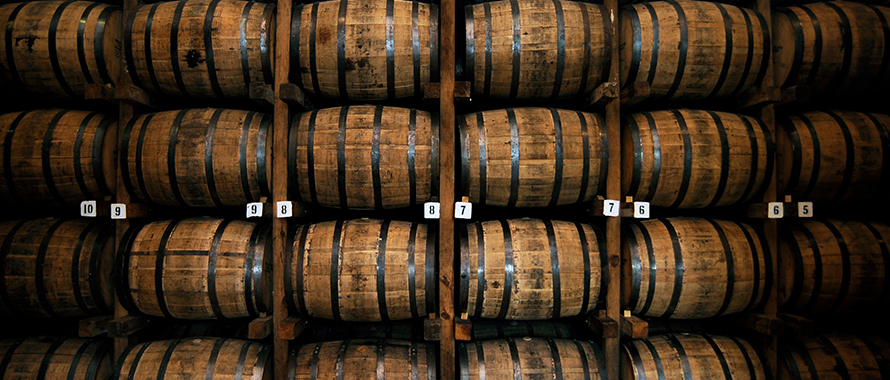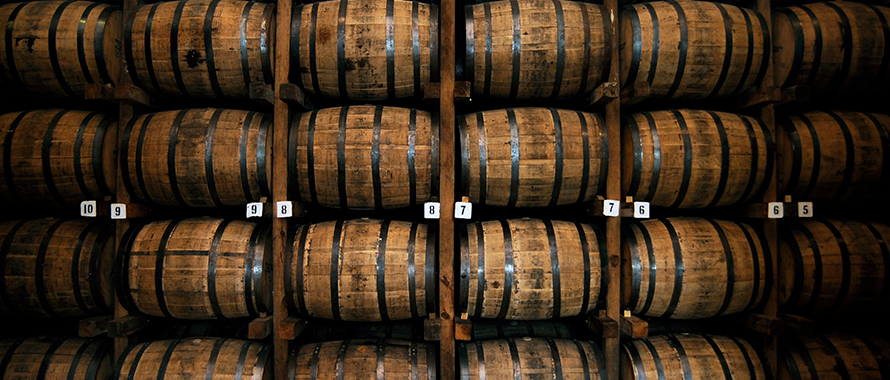
On July 2, lightning struck and ignited a fire at two Jim Beam distillery warehouses in Versailles, Kentucky. The fire, fueled by the 45,000 barrels—over 2 million gallons—of bourbon, burned for several days and reduced one warehouse and its contents to rubble.
Bourbon from barrels destroyed in the fire flowed from the site into nearby Glenns Creek, the Kentucky River and finally the Ohio River. The resulting 23-mile-long “plume” of bourbon depleted oxygen in the water and killed an undetermined number of fish, which washed ashore as far as Indiana.
A spokesman for the Kentucky Energy and Environment Cabinet indicated that Beam Suntory, the Chicago-based company that owns Jim Beam, will be assessed penalties for the pollution of the river as well as for the depletion of fish stocks. The company is working with U.S. Environmental Protection Agency (EPA) officials to assess damages and plan remediation efforts.
Late last month officials for the Peaks Mill Water District in Woodford County, Kentucky reported that run-off from the Jim Beam fire had entered its water lines and prompted complaints about taste and odor.
“Anything present in excess and anything outside of its natural environment is a pollutant,” said Gina Jones, Vice President, Director, Environmental Programs, Burns & Wilcox, Denver, Colorado.
Because bourbon itself is not caustic or hazardous it is not generally thought of as a pollutant. “However,” said Jones, “when bourbon is no longer contained in barrels in a warehouse and is seeping into rivers and elsewhere it becomes a pollutant, and a pretty severe pollutant at that. Many natural resources cannot survive that (level of pollution).”
Warehouses face extensive risks
Kentucky has had to contend with a number of bourbon-warehouse-related accidents during the last two decades, including a massive 1996 fire that destroyed seven Heaven Hill warehouses holding 90,000 barrels of bourbon and caused extensive environmental damage.
“Anything present in excess and anything outside of its natural environment is a pollutant.” – Gina Jones, Burns & Wilcox
In June 2018, a warehouse at a Barton 1792 distillery in Bardstown partially collapsed and then collapsed completely two weeks later. In June this year a warehouse partially collapsed at the O.Z. Tyler distillery in Owensboro. The warehouse will be demolished once the nearly 20,000 intact barrels of bourbon are removed from the wreckage—one barrel at a time—and relocated.
The risks associated with warehouses extend far beyond this particular subset of cases, however. Warehouses with contents of all kinds face a number of risks, including severe weather, malicious acts, equipment failure, fires and more.
In the past two weeks, fires have destroyed a number of warehouses and their contents in the U.S. and Canada, including a theatrical supplies warehouse in South Bend, Indiana on July 27 and a restaurant supply warehouse in Brooklyn, New York on August 1. On July 26, a warehouse the size of a city block was destroyed in a massive fire in Winnipeg, Manitoba, Canada. The building contained decades’ worth of works by local artists, all of which were lost in the blaze.
According to a National Fire Protection Association (NFPA) report and fact sheet, U.S. fire departments responded to an estimated average of 1,210 warehouse fires annually from 2009 to 2013, not including refrigerated or cold storage warehouses, resulting in an average $155 million annually in direct property damage alone.
Fire statistics in Canada are staggering as well. According to data collected in the National Fire Information Database, Statistics Canada reports an annual average of 1,538 fires at storage properties between 2010 and 2014. This figure includes facilities other than warehouses, such as auto repair shops.
As role of warehouses expands, risks increase
“We are in an age when more (consumers are ordering goods online), so warehouses are becoming more critical than ever (to business’ operations and economic success),” said Barry Whitton, Managing Director, Burns & Wilcox Brokerage, Atlanta, Georgia.
“There are simply more third-party warehouses (in operation) now,” Whitton said. “Many warehouse companies do not own any of the products they store in their facilities, which can contain a variety of product (types)—everything from electronics to clothing and more.”
When a warehouse is destroyed or unable to operate for a significant period of time, the impacts can extend far beyond a loss of inventory, Whitton said. If an entire business is based on storing and distributing goods for third parties, that business, its customers and its entire distribution network could face a myriad of losses following a fire or similar event: Business Interruption, damaged third-party goods, loss of revenue, and more.
When considering potential risks, he said, it is important “to consider the goods flowing into and out of a warehouse—if you interrupt either of those lines a warehouse can suffer some sort of Business Interruption or other loss.”
Fortunately, coverage to help business owners recover from all of these types of losses is available through a Commercial Property Insurance policy, Whitton said.
Implementing protections, mitigating losses
To best protect against loss of stock in the wake of a weather event, fire or flood, Whitton said, “warehouses must be designed for the goods stored inside them.” For example, he explained, a warehouse storing electronics equipment has a different fuel load than a warehouse filled with bourbon or clothing. “All of those things burn differently.”
The NFPA has codes and standards available to help reduce the incidence of fires in warehouses and mitigate the damages they cause. These standards provide guidelines for fire-extinguishing substances and systems, best practices, code requirements, safe storage of different types of materials and more.
“You take the right steps to design the warehouse around (everything that it stores) to help prevent and minimize losses, and you have a Commercial Property Insurance policy behind it all in case a loss occurs.” – Barry Whitton, Burns & Wilcox Brokerage
Other precautions intended to increase safety and reduce fire-related losses are advisable, according to Whitton. Storage rack systems can integrate sprinklers in each level, for instance, and items such as aerosol cans of spray paint can be stored in cage-like racks that prevent them from becoming high-velocity projectiles when ignited.
Proper employee training, proper supervision of contractors and strict enforcement of non-smoking policies are other types of preventive maintenance aimed at reducing the incidence of fire in warehouses, Whitton said.
“You take the right steps to design the warehouse around (everything that it stores) to help prevent and minimize losses, and you have a Commercial Property Insurance policy behind it all in case a loss occurs.”
Mitigating environmental-related losses
The barrels of bourbon lost in the recent Jim Beam warehouse fire were “relatively young,” according to Beam Suntory, which means they held less value than barrels of older stock, and represented approximately 1.4 percent of the company’s Kentucky-based inventory. One expert estimated the company’s total cost of lost inventory, site clean-up and rebuilding at $50 million.
The cost to remediate environmental damage done by the leaking bourbon is also likely to be substantial. When a warehouse filled with Wild Turkey whiskey collapsed in May 2000, the company paid over $250,000 to restock fish in the Kentucky River—in that incident the 28-mile-long alcohol plume from 17,000 leaked barrels killed over 200,000 fish.
In recent fiscal years penalties collected by the EPA for environmental damages have been considerable: more than $6 billion in 2016, just over $1.5 billion in 2017 and nearly $70 million in 2018. These totals do not include any fines levied by state or local entities or hard costs of site remediation. Actual costs can range from several thousand to several hundred million dollars per incident.
Nevertheless, according to Jones, “less than 10 percent of all environmental losses are insured.” This can be partly attributed to widespread misinformation about the cost and scope of Environmental Insurance coverage available, she explained. “There is a perception that premiums for Environmental Insurance coverage are high and coverage is restricted, but that is really not the case.”
Environmental Insurance policies can be custom tailored to the exposures facing any business, Jones said. Policies can include coverage for Pollution Legal Liability; Environmental Impairment Liability at owned, non-owned, rented or permanently-leased locations; On-site or Off-site Clean-up; Emergency Response Costs; Business Interruption and many other costs of remediating environmental damage in a wide range of locations, such as aerating waterways to restore normal oxygen levels following a bourbon spill.
“Our Environmental Insurance policies are customized based on the needs and requirements of a given insured party,” Jones said. “They can include coverage for items stored at locations the insured does not own, transportation-related pollution release, storage tank exposures, disposal site exposures – whatever the client needs. They can be pretty broad.”
Environmental Insurance policies can also include coverage for fines and penalties, where allowable by law.
Premiums for Environmental Insurance policies providing a broad range of coverage can be as low as $2,500 or $5,000, Jones said. “We understand what the environmental exposures are (for business owners) and we underwrite that.”
Appropriate coverage, maximum value
When insurance brokers and agents assess the appropriate protections for clients’ warehouses and their contents, Whitton said, they start by determining the maximum value of the goods stored in the facility at any given time. Also considered are inventory turnover rates and any potential legal liability exposures the insured may have related to warehouse operation or inventory.
“Absence of loss does not necessarily mean absence of risk. The reality is that every business has an environmental exposure—every single one.” – Jones
“If a properly insured business is at fault for a loss of stock, the policy will help cover costs like replacing inventory owned by a third party,” said Whitton. Such losses can be caused by everything ranging from acts of God to employee errors to malfunctioning equipment.
“The basic rule of Commercial Property Insurance is to cover everything and to cover it adequately,” Whitton said. This means working with an insurance broker or agent to continually ensure all potential risks are accounted for and properly assessed in your Commercial Property Insurance policy.
Businesses that invest in Environmental Insurance coverage tend to have “savvy risk managers in place,” Jones said. All business owners would do well to consult risk management experts as well as expert insurance brokers and agents to fully understand the environmental and pollution-related risks they face before and after incurring a loss, Jones said.
“Absence of loss does not necessarily mean absence of risk,” Jones emphasized. “The reality is that every business has an environmental exposure—every single one.”
As with any coverage need, an insurance broker or agent must be consulted.
This information was provided by Burns & Wilcox, North America’s leading wholesale insurance broker and underwriting manager. Burns & Wilcox works exclusively with retail insurance brokers and agents to assist clients like you with their specialty insurance needs.
Learn more about Commercial Property Insurance and Environmental Insurance.
